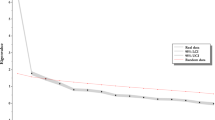Abstract
This chapter builds on the parental involvement factors defined in chapter two, and examines how these may be reflected in the IEA’s PIRLS-2011 home, student and school questionnaire. Five scales to measure parental involvement are proposed and described.
You have full access to this open access chapter, Download chapter PDF
Similar content being viewed by others
Keywords
Our analysis of the PIRLS-2011 data of 41 countries was guided by the analytic framework (Table 3.1), which was based on the general framework (Table 2.1) we used to categorize the studies included in the literature review. The analytic framework matches the available indicators of parental involvement in the PIRLS-2011 data (Table 3.2).
The first dimension, i.e. home-based involvement from the perspective of parents, was split into two components or indicators: early literacy activities and help with homework. The early literacy activities component is especially well measured by the PIRLS home questionnaire. In the international reports of PIRLS-2011, early literacy activities is the only component reported as a scale, with Cronbach’s alphas ranging from 0.70 (Czech Republic, Hungary, Italy and Oman) to 0.88 (Romania), indicating high reliability (Martin and Mullis 2012). Although the international report does not report the scale statistics on the items regarding parental help with homework, this component is well addressed, as a total of eight items ask about these practices.
To consider the dimension of school-based involvement and home-school communication from the parent’s perspective (component 3 in the analytic framework), three relevant items were selected from the home questionnaire. The number of items for this indicator is low, but the items do seem highly relevant to this context. The student’s perception of parental involvement and the school’s practices on parental involvement (corresponding to components 4 and 5 in the analytic framework) are measured by five items in the student questionnaire and 15 items in the school questionnaire, respectively. Finally, we established the outcome variable and control variables for the structural multilevel model tested later (Table 3.2): the PIRLS reading literacy achievement scores, gender of the student, and, as approximates for SES, both books at home and highest level of education of the parents.
The benefit of using data from a large-scale assessment study such as PIRLS is not only the richness in data resulting from achievement tests, as well as student, home, teacher and school questionnaires, but also, obviously, the large number of countries for which these data are available. For this study, we initially considered the data from 43 countries participating in PIRLS-2011; countries not meeting the required response rate or for which the average achievement was not reliably measured were excluded. However, two countries, England and the USA, did not administer the home questionnaire and were therefore not included in the scale analyses for components 1–3, using items from the home questionnaire.
References
Foy, P., & Drucker, K. T. (Eds.). (2013). PIRLS 2011 user guide for the international database. Chestnut Hill, MA, USA: TIMSS & PIRLS International Study Center, Boston College.
IEA, & TIMSS and PIRLS International Study Center (2011). TIMSS and PIRLS press release 2011. PIRLS 2011 contextual questionnaires. Retrieved from http://timssandpirls.bc.edu/pirls2011/international-contextual-q.html.
Martin, M. O., & Mullis, I. V. S. (Eds.). (2012). Methods and procedures in TIMSS and PIRLS 2011. Chestnut Hill, MA, USA: TIMSS & PIRLS International Study Center, Boston College.
Author information
Authors and Affiliations
Corresponding author
Rights and permissions
Open Access This chapter is distributed under the terms of the Creative Commons Attribution-NonCommercial 4.0 International License (http://creativecommons.org/licenses/by-nc/4.0/), which permits any noncommercial use, duplication, adaptation, distribution, and reproduction in any medium or format, as long as you give appropriate credit to the original author(s) and the source, a link is provided to the Creative Commons license, and any changes made are indicated. The images or other third party material in this chapter are included in the work’s Creative Commons license, unless indicated otherwise in the credit line; if such material is not included in the work’s Creative Commons license and the respective action is not permitted by statutory regulation, users will need to obtain permission from the license holder to duplicate, adapt, or reproduce the material.
Copyright information
© 2016 The Author(s)
About this chapter
Cite this chapter
Punter, R.A., Glas, C.A.W., Meelissen, M.R.M. (2016). Parental Involvement in PIRLS-2011. In: Psychometric Framework for Modeling Parental Involvement and Reading Literacy. IEA Research for Education, vol 1. Springer, Cham. https://doi.org/10.1007/978-3-319-28064-6_3
Download citation
DOI: https://doi.org/10.1007/978-3-319-28064-6_3
Published:
Publisher Name: Springer, Cham
Print ISBN: 978-3-319-28710-2
Online ISBN: 978-3-319-28064-6
eBook Packages: EducationEducation (R0)




